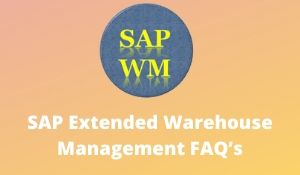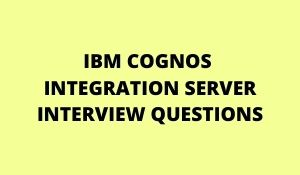
How SAP EWM is different from SAP Warehouse Management?
SAP EWM is part of SAP Supply chain management like the Warehouse management system but provides more robust and advanced features to manage key activities in the Warehouse.
SAP Extended Warehouse Management EWM is similar to Warehouse management but it provides more features like picking, putting away, RF framework, Warehouse structure, and more flexible options to manage warehouse functions.
You can create new elements like activity areas, resources, labor management, and work centers in SAP EWM which were not available in WM.
SAP EWM provides a more robust solution to manage warehouse functions in an organization. It is also a part of SAP Supply Chain Management and supports all the processes within the logistics and supply chain.
What are the different deployment options in EWM?
SAP EWM can be considered as deployed in an ERP server or you can also consider it as an application in the Supply chain Management landscape.
SAP EWM is integrated with ERP to access transaction and master data and the use of features like slotting, and availability checks also requires integration with CRM.
SAP EWM is considered a separate application and shares the same server with SCM applications. You can also run SAP EWM in its own SCM environment which is suitable to get improved performance.
EWM Deployment options −
- SAP EWM on SCM Server
- SAP EWM as Standalone
What are the different types of Organization Units?
There are different organization units in a Warehouse system at different levels −
- Warehouse Number − Each warehouse consists of a warehouse number which is at the highest level in a warehouse management system. Each warehouse number consists of a sub-structure that maps the warehouse relationship.
- Storage Type − There are different types of storage where products are physically stored in a warehouse such as open storage, goods issue, and goods receipt, racks.
- Storage Section − This is a part of the storage type and represents a group of bins with the same characteristics. Commonly used storage sections are fast-moving or slow-moving items, etc.
Explain SAP Extended Warehouse Management EWM?
SAP EWM is used to efficiently manage inventory in the Warehouse and to support processing of goods movement. It allows the company to control its Warehouse’s inbound and outbound processes and the movement of goods in the Warehouse.
The main processes in a Warehouse are incoming and outgoing materials, goods receipt and goods issue, fulfilling customer orders, and distribution of goods. When a company doesn’t store any goods, then there is no need for Warehouse management to manage goods.
The inbound process involves the storage of goods in the warehouse and their location and the Outbound process involves picking up the goods. Whenever a material is stored in a warehouse, it is stored in a storage bin and you can find its current location.
What is Quant?
The quantity of goods in the storage bin is represented by Quant. The quant is used for managing inventory in a storage bin.
What is a Storage bin?
Storage bins represent the physical location of storage space where the products are stored in the Warehouse. They are at the lowest level of organization structure and when you store an item in a Warehouse you need to mention its exact location.
What is the use of Activity areas in Storage bin?
Storage bins are further categorized into activity areas. It includes activities like picking, putting away, or a physical inventory. As per activity, you can assign the same storage bin to multiple activity areas.
What are the different Warehouse process types in the SAP EWM system?
Different Warehouse process categories are predefined in the EWM system −
- Stock Removal
- Putaway
- Internal Movement
- Goods receipt posting
- Goods issue posting
- Physical inventory
- Cross Line putaway
What are the pick pack and pass of goods in the EWM system?
This is used to manage the picking, packing, and transportation of goods in activity areas in the warehouse. This can be used in an RF environment commonly and the process flow is the same as for standard RF process. In pick, pack, and pass goods are moved from the activity area to the activity area till they arrive at the destination point in the system.
| Learn more information from the GoLogica “SAP ABAP Training“ |
What the different types are of cross-docking?
There are different types of cross-docking available in the SAP system −
- Transportation cross-docking
- Merchandise Distribution
- Push deployment
- Pick from goods receipt
- Opportunistic Cross-docking
What is an hoc physical inventory?
Ad-hoc physical inventory is a type of continuous physical inventory and It can be executed anytime during the fiscal year, an ad hoc physical inventory may become necessary.
What is Storage Control?
Storage control is used to determine product movements in the warehouse. It is used to execute the putaway or stock removal process in the warehouse.
What is the requirement for the Purchase order items that are included when the inbound delivery is created?
They should have a confirmation control key
Where can we find the exact whereabouts of a material quantity in the warehouse?
Storage bins. In Warehouse Management, Storage bins are master data created either from the application menu or in Customizing.
Based on this master data, the stock overview in Warehouse Management shows the exact whereabouts of a material quantity in the warehouse.
What are the transactions available to create a transfer order for moving partial stocks within a warehouse number?
Two transactions are available to create a transfer order for moving partial stocks within a warehouse number:
- Create Transfer Order without Source Object (transaction code LT01)
- Create Transfer Order from Stock List (transaction code LT10)
What happens when no storage location for picking is specified in the order item?
- a) The system determines the storage location when it creates the outbound delivery and copies it into the delivery item.
- b) The storage location entered in the order item is used in the outbound delivery
What are the types of Storage Control?
There are two types of storage control −
- Layout Oriented
- Process Oriented
In SAP Extended Warehouse Management, process-oriented storage control is executed first and layout storage control is executed to check if the putaway step is possible in the warehouse layout view and also adjust the putaway or stock removal as per the layout view.
For what processes the Work Center can be used?
A Work Center can be used for the following processes −
- Packing
- Deconsolidation
- Counting
- Quality check
What are the types of physical inventory procedures?
SAP EWM supports three types of physical inventory procedures −
- Periodic − The system is configured to perform an inventory on a specific day or over a short period.
- Continuous − This can be executed anytime during the physical period year.
- Cycle Counting − You have divided the objects into categories – A, B, C, and D. In customizing, you define the cycle counting indicator codes with an interval (in work days) after which a new physical inventory should be performed.
What is Cross Docking?
Cross-docking allows you to reduce the costs of goods transportation in a warehouse and shorten the time needed for delivery. Cross docking only creates one movement – GR Zone to GI Zone and can only be used if the stock for removal is not determined by First in – first out.
Related Articles:
🎯 SAP VC Tutorial
🎯 What Is SAP BPC 11.0?
🎯 Features And Functionality – SAP BPC
🎯 Introduction To Financial Consolidation – SAP BPC
🎯 Crystal Reports Tutorial – GoLogica
🎯 A Complete Guide to SAP Variant Configuration
🎯 SAP BPC Tutorial for Beginners
🎯 SAP Simple Finance Interview Questions











